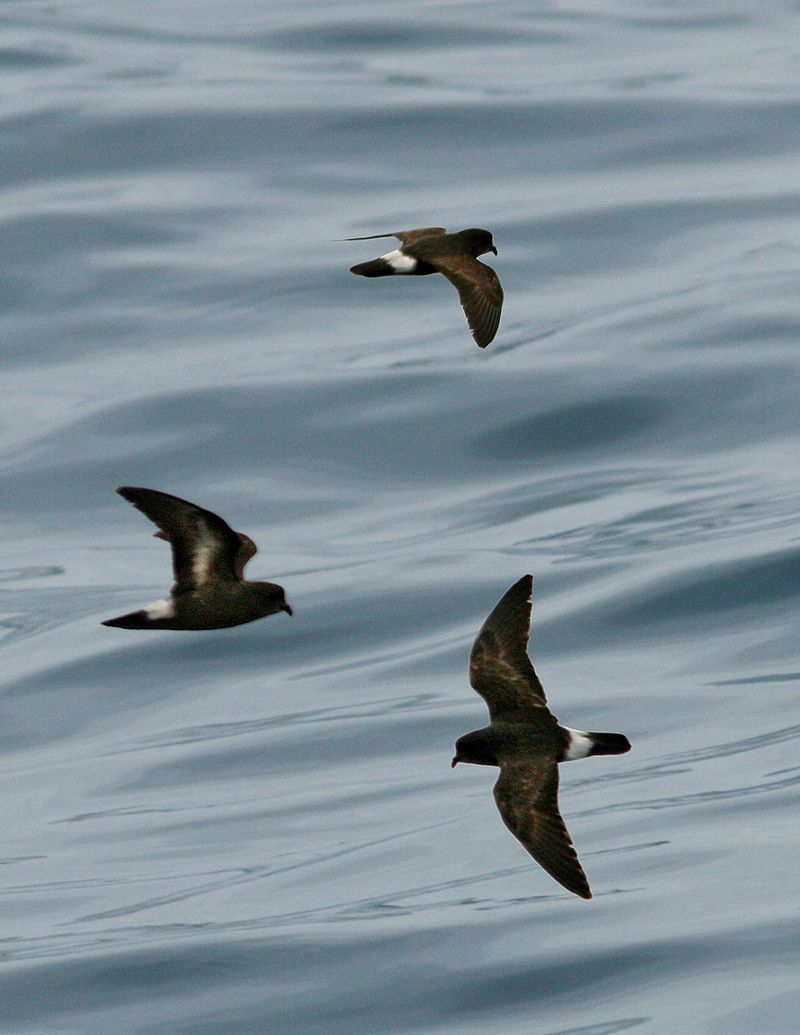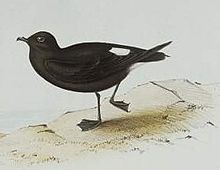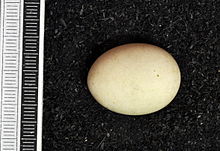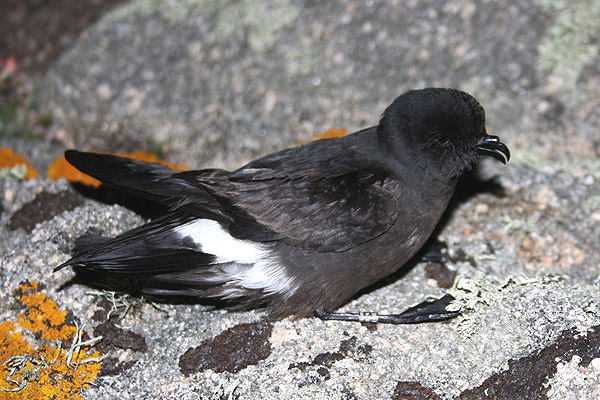The storm petrel nests in crevices and burrows, sometimes shared with other seabirds or rabbits, and lays a single white egg, usually on bare soil. The adults share the lengthy incubation and both feed the chick, which is not normally brooded after the first week. This bird is strongly migratory, spending the northern hemisphere winter mainly off the coasts of South Africa and Namibia, with some birds stopping in the seas adjoining West Africa, and a few remaining near their Mediterranean breeding islands. This petrel is strictly oceanic outside the breeding season. It feeds on small fish, squid and zooplankton while pattering on the sea's surface, and can find oily edible items by smell. The food is converted in the bird's stomach to an oily orange liquid which is regurgitated when the chick is fed. Although usually silent at sea, the storm petrel has a chattering call given by both members of a pair in their courtship flight, and the male has a purring song given from the breeding chamber.
The storm petrel cannot survive on islands where land mammals such as rats and cats have been introduced, and it suffers natural predation from gulls, skuas, owls and falcons. Although the population may be declining slightly, this petrel is classified by the International Union for Conservation of Nature as being of Least Concern due to its high total numbers. Its presence in rough weather at sea has led to various mariners' superstitions, and, by analogy, to its use as a symbol by revolutionary and anarchist groups.

Taxonomy
The storm petrels, Hydrobatidae, are one of the four major families of the Procellariiformes or "tubenoses", an order of seabirds that also includes the albatrosses, the Procellariidae, and the diving petrels.[2] The family is an ancient group of small species which is thought to have diverged early from the rest of the tubenoses; the supporting fossil record is poor, with specimens from California dating back only to the Late Miocene (11.6–5.3 million years ago). The Hydrobatidae are often divided into two subfamilies, the mainly southern hemisphere Oceanitinae and the northern Hydrobatinae;[3] cytochrome b DNA sequence analysis suggests that these might be full families.[4] The European storm petrel is the only member of the genus Hydrobates, the remainder of the Hydrobatinae being placed in Oceanodroma, although the least storm petrel is sometimes separated as the sole member of Halocyptena.[3] The relationships within the Hydrobatinae are complex and uncertain, and it has been suggested that all the members of the subfamily could be subsumed into an enlarged Hydrobates.[5]The storm petrel was first described from by Linnaeus in his Systema naturae in 1758 as Procellaria pelagica.[6] It was moved to the genus Hydrobates by Friedrich Boie in 1822.[7][8] Petrel, first recorded in 1602, is a corruption of pitteral, referring to the bird's pitter-pattering across the water. The suggestion that the word refers to St Peter walking on the waves is a later invention. Storm arises from seamen's association of this bird with bad weather.[9] In English, the name of the species was written as "stormy petrel" by some 19th-century authors.[10]
The scientific name derives from Greek; Hydrobates is from hudro, water, and bates, walker,[11] and pelagicus is from pelagikos, of the sea.[12][13] There are two recognised subspecies, the North Atlantic nominate subspecies, H. p. pelagicus (Linnaeus, 1758), and the Mediterranean H. p. melitensis (Schembri, 1843).[2] Although there is some genetic support for classifying the southern form as a separate species,[14] the morphology is not considered sufficiently different from that of the nominate subspecies to justify a split.[3]
Description
Storm petrels cannot walk on land, and shuffle on their tarsi.
Old illustrations, such as this by John Gould, were painted from skins, and showed petrels in improbable standing positions.[15]
Moult is prolonged in all tubenoses, since they must maintain an ability to fly. Northern populations start replacing their plumage after those further south, reflecting the later start to their breeding season. Birds in a Welsh colony commenced moulting in early August, while populations in northern Spain and the Balearics started in early July and mid-June respectively. Breeding birds moult later than non-breeders.[21]
The storm petrel's large nasal olfactory bulbs facilitate a keen sense of smell,[22] and the birds themselves have a distinctive musty aroma which can help researchers to locate breeding colonies.[23] Individual petrels recognise their own body scent and can use it to locate their nest in the dark.[24]
The flight is weak-looking and resembles that of a bat, with fluttering interspersed with short glides. When feeding, the birds hang with raised wings and patter on the surface with their feet, but, unlike the Wilson's storm petrel, do not look as if they are walking on the water. Birds will sometimes settle on the sea.[16] Like other petrels, the European storm petrel cannot walk properly on land, but shuffles on its tarsi;[25] once there is enough room, the bird flaps its wings to support itself on its toes.[26]
The European storm petrel can be distinguished from related Western Palaearctic species by the white bar on its underwing and its distinctive fluttering flight. Compared to Leach's storm petrel, band-rumped storm petrel, and the recently described Monteiro's storm petrel, it is also smaller, darker, shorter-winged and has a square tail. Wilson's storm petrel lacks an underwing bar, and has long legs with the feet visible beyond the tail.[16]
Voice
Storm Petrel churring calls
Distribution and habitat
Storm petrels breed only in the Western Palaearctic on islands off the Atlantic and Mediterranean coasts of Europe.[16] The largest colonies are in the Faroe Islands (150,000-400,000 pairs), United Kingdom (20,000-150,000), Ireland (50,000-100,000) and Iceland (50,000-100,000), with smaller breeding areas off Norway, Malta, Spain, the Canary Islands, Italy, France and Greece.[1] The strongholds of the melitensis subspecies are the island of Filfla (Malta), Sicily and the Balearic Islands, with smaller sites elsewhere in the Mediterranean. This latter form also breeds in North Africa; definitely in Tunisia, probably in Algeria and possibly in Morocco.[17] Because of its nocturnal habits and the problems of accessing some of the small islands on which it breeds, the distribution is poorly known. A colony was discovered as recently as 2009, on Lampedusa.[23] The storm petrel has been recorded as a vagrant in several European countries as far east as the Ukraine, in the Guinea region of West Africa, and in Turkey, Israel, Lebanon,[1] and the US.[30] Although there were no North American records for more than 30 years after the first in 1970, this bird has been more or less annual in small numbers since 2003.[31]The storm petrel breeds on exposed and usually uninhabited islands which it visits only at night. It otherwise frequents mid-depth waters away from the coastal zone, but not over the ocean deeps. In the breeding season, it is mainly found between the 10–25 °C July isotherms.[16] In Europe, it is rarely seen from land except in autumn storms.[32]
The storm petrel is migratory, spending the northern hemisphere winter mainly in cool waters off the coasts of South Africa and Namibia, south to latitude 38°S and east to KwaZulu-Natal.[16][33] Some birds stay north of the equator in the seas adjoining Mauritania and Rio de Oro, and a few remain near the breeding islands, especially in the Mediterranean. It is strictly oceanic outside the breeding season,[16][34] although it is described as regularly seen from land in West Africa.[35] Young birds do not return to the breeding colonies until their second or third year. Birds mostly head south from the breeding islands between September and November, reaching West Africa by mid-November and the south Atlantic by the end of the year. The return passage starts in April, with late records from the tropics and further south probably representing sub-adult birds that will not breed that year.[16]
Behaviour
Breeding
The storm petrel is sexually mature at age 4–5 years, with the Mediterranean subspecies typically breeding a year earlier than the Atlantic form. Breeding happens in colonies and normally begins in late May or June.[23][34] Pairs have a repeated nocturnal display flight in which the male chases the female, the chase being accompanied by flight calls. Some near-adult birds may pair up and occupy a hole at the same time, prior to breeding in the following year.[16]Storm petrels normally nest in crevices between or under rocks, or burrow in the soil.[16] When they make their own tunnels, they loosen the earth with their bills and kick out the debris with their feet. The birds less commonly nest in walls, under buildings or down rabbit burrows. Disused or occupied burrows of Atlantic puffins and Manx shearwaters are sometimes used, and the petrel pair may share a common entrance with those seabirds, rabbits or other pairs of its own species. Where other occupants are present, the petrels dig a side burrow or use an existing low-roofed tunnel which the larger birds or rabbits cannot easily enter. Even so, puffins and shearwaters will sometimes access and destroy nests, and adult petrels may be killed by their larger neighbours.[28] Human-made plastic nesting tubes are readily used, and may provide protection against predators.[17][36] Birds usually mate for life and use the same hole every year.[28]
The nest tunnel is 10–300 cm (3.9–118.1 in) long and 5–8 cm (2.0–3.1 in) across, with a slightly narrower entrance. The nest chamber is typically unlined, although pairs may bring in some grass, bracken or seaweed. Although the storm petrel is generally non-territorial when breeding, a pair will defend the nest chamber itself after the eggs have been laid.[16]
Egg, Collection Museum Wiesbaden
Tubenoses have smaller egg clutches and much longer and more variable incubation and fledging times than passerines with similarly sized eggs, resembling swifts in these developmental factors. Tubenoses and swifts have generally secure nest sites, but their food sources are unreliable, whereas passerines are vulnerable in the nest but food is usually plentiful.[41][42] In the particular case of the storm petrel, it has a body temperature perhaps 3 °C lower than other small birds, and this may also contribute to the lengthy incubation.[40]
The adult petrel's annual death rate is 12–13%,[34] and the typical life span is 11 years. Longevity records established from bird ringing recoveries include a bird aged 31 years 11 months 9 days,[37] and another aged more than 33 years.[43]
Feeding
The typical prey consists of surface organisms such as small fish, squid, crustaceans and jellyfish. The storm petrel will also eat offal and oily food, often located by smell, and will follow ships.[16][50] In the Atlantic, more than half the food items are zooplankton and the fish caught include small herring and sprats; whale carcasses are scavenged where available. During digestion, the plankton is quickly converted to an oily orange liquid that owes its colour to carotenoids. Larger prey items take longer to digest.[44] The oil, rich in vitamin A, is produced by a large gland in the stomach.[51] The Mediterranean subspecies' diet is mainly fish, particularly Mediterranean sand eels. Petrels also catch opossum shrimps from waters close to the colony.[17] Bluefin tuna farms are exploited on the Maltese island of Filfla; birds from the large local colony feed on the unwashed food fed to the farmed tuna, a mixture of fish, squid and prawns which produces a sizeable oily slick.[52] Small numbers of insects are caught near breeding colonies, and some plant material, including angiosperm seeds and sorrel, has been found in the stomach contents.[15][44] A study on Leach's storm petrel, which consumes similar items, showed that the petrels were snipping pieces off plant leaves in flight, but it could not be confirmed that this was in the course of catching insects.[53] Nasal glands remove excess salt from seawater consumed by the petrel as a concentrated solution excreted through the nostrils.[51]
Petrels can be attracted to boats with "chum", a malodorous mixture typically containing fish heads, bones and offal, with added fish oil and popcorn to aid flotation. An apparently empty ocean will soon fill with hundreds of birds attracted by the smell. The attraction of the fishy odour is sometimes enhanced by the addition of dimethylsulphide (DMS) a chemical also naturally produced by some planktonic organisms, although there are doubts about the safety of this possible carcinogen.[45][54]
Predators and parasites
The Eleanora's falcon is a local predator on some Mediterranean islands
Feather mites of at least two species have been found on the storm petrel, with Halipeurus pelagicus occurring at much higher densities than Philoceanus robertsi.[57] The flea Xenopsylla gratiosa and dermanyssid mites are commonly found, with lower numbers of ticks. These blood-sucking parasites slow the growth rate of nestlings and may affect their survival rate.[58]
Storm petrels seem to be largely free of blood parasites, even when in close proximity to carrier species such as the yellow-legged gull.[59][60] It has been suggested that seabird species with long incubation periods and long lives have well-developed immune systems that prevent serious blood parasitism.[61]
Status
The European population of the storm petrel has been estimated at 430,000–510,000 breeding pairs or 1,290,000–1,530,000 individual birds and makes up 95% of the world total numbers.[3] The population estimate includes about 11,000 to 16,000 breeding pairs of the Mediterranean subspecies.[17]Although this species' population now appears to be declining, the decrease is not rapid or large enough to trigger conservation vulnerability criteria. Given its high numbers, this petrel is therefore classified by the International Union for Conservation of Nature as being of Least Concern. The perceived decline may be due increased predation from gulls, skuas and introduced mammals.[1] Eradication of rats protects seabird colonies and may enable recolonisation of islands cleared of rodents.[56] Predation of cave-nesting petrels in the Balearics by yellow-legged gulls is restricted to relatively few individual gulls specialising in this prey item;[62] this means that the problems can be controlled by selective culling and the provision of plastic nest boxes.[63]
Because it feeds in flight, the storm petrel is less affected by oil pollution than other seabirds, and may be able to use its good sense of smell to avoid slicks, although a large spill near a breeding colony could have serious consequences.[3]
In culture

Its association with storms makes the storm petrel a bird of bad omen to mariners; they are said to either foretell or cause bad weather.[64] A more prosaic explanation of their appearance in rough weather is that, like most oceanic seabirds, they rely on the winds to support them in flight and just sit on the water surface when becalmed.[65] The birds were sometimes thought to be the souls of perished sailors,[66] and killing a petrel was believed to bring bad luck.[64][66] The petrel's reputation led to the old name of witch,[9] although the commonest of the folk names is Mother Carey's Chicken, a name also used for storm petrels in general in the UK and USA from at least 1767.[67] This is believed to be a corruption of mater cara (dear mother, the Virgin Mary), a reference to the supernatural Mother Carey, or a superstitious modification of an earlier Mother Mary's Chicken to reduce the potency of the religious name.[66] The Mother Carey character appears a number of times in literature. In the Cicely Fox Smith poem "Mother Carey", she calls old sailors to return to the sea,[68] but in John Masefield's poem of the same name she is seen as a wrecker of ships.[69] She appears as a fairy in Charles Kingsley's The Water Babies and is depicted in one of Jessie Willcox Smith's illustrations for the book.[70]
The association of the storm petrel with turbulent weather has led to its use as a metaphor for revolutionary views,[71] the epithet "stormy petrel" being applied by various authors to characters as disparate as Roman tribune Publius Clodius Pulcher,[72] a Presbyterian minister in the early Carolinas,[73] an Afghan governor,[74] or an Arkansas politician.[75]
A 1901 poem by Russian writer Maxim Gorky is invariably titled in English as "The Song of the Stormy Petrel", although that may not be a perfectly accurate translation of the Russian title "Песня о Буревестнике", because "Буревестник" (the name of the bird in Russian) translates to the English general term "storm bird".[a] The poem was called "the battle anthem of the revolution", and earned Gorky the nickname "The Storm Petrel of the Revolution".[77]
Various revolutionary anarchist groups adopted the bird's name, either as a group identifier, as in the Spanish Civil War,[78] or for their publications. The Stormy Petrel (Burevestnik) was the title of the magazine of the Anarchist Communist Federation in Russia around the time of the 1905 revolution,[79] and is still an imprint of the London group of the Anarchist Federation (Britain and Ireland).[80] To honor Gorky and his work, the name Burevestnik was bestowed on a variety of institutions, locations, and products in the USSR.[71]








No comments:
Post a Comment
Note: Only a member of this blog may post a comment.